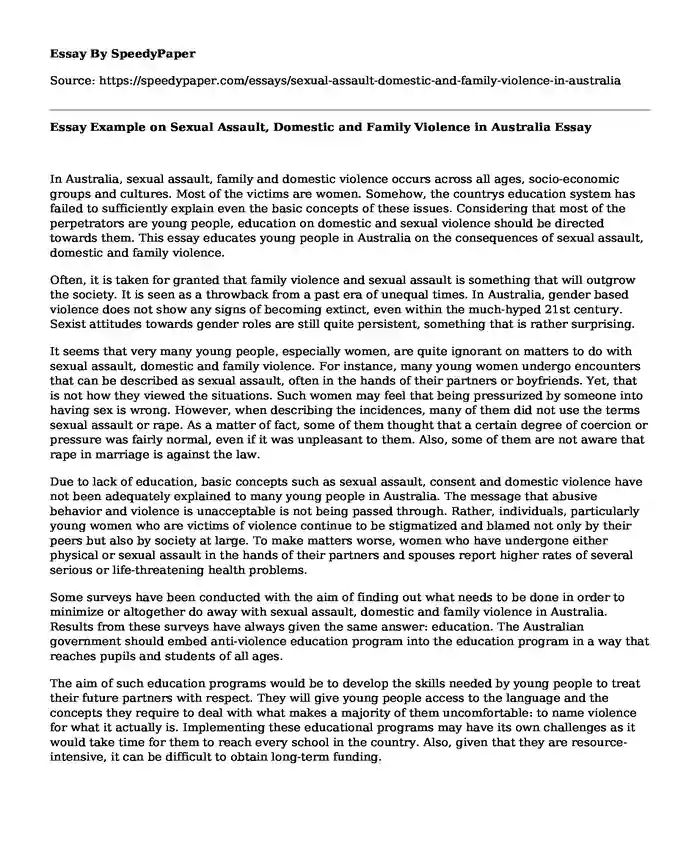
| Type of paper: | Essay |
| Categories: | Family Domestic violence Sexual assault |
| Pages: | 3 |
| Wordcount: | 740 words |
In Australia, sexual assault, family and domestic violence occurs across all ages, socio-economic groups and cultures. Most of the victims are women. Somehow, the countrys education system has failed to sufficiently explain even the basic concepts of these issues. Considering that most of the perpetrators are young people, education on domestic and sexual violence should be directed towards them. This essay educates young people in Australia on the consequences of sexual assault, domestic and family violence.
Often, it is taken for granted that family violence and sexual assault is something that will outgrow the society. It is seen as a throwback from a past era of unequal times. In Australia, gender based violence does not show any signs of becoming extinct, even within the much-hyped 21st century. Sexist attitudes towards gender roles are still quite persistent, something that is rather surprising.
It seems that very many young people, especially women, are quite ignorant on matters to do with sexual assault, domestic and family violence. For instance, many young women undergo encounters that can be described as sexual assault, often in the hands of their partners or boyfriends. Yet, that is not how they viewed the situations. Such women may feel that being pressurized by someone into having sex is wrong. However, when describing the incidences, many of them did not use the terms sexual assault or rape. As a matter of fact, some of them thought that a certain degree of coercion or pressure was fairly normal, even if it was unpleasant to them. Also, some of them are not aware that rape in marriage is against the law.
Due to lack of education, basic concepts such as sexual assault, consent and domestic violence have not been adequately explained to many young people in Australia. The message that abusive behavior and violence is unacceptable is not being passed through. Rather, individuals, particularly young women who are victims of violence continue to be stigmatized and blamed not only by their peers but also by society at large. To make matters worse, women who have undergone either physical or sexual assault in the hands of their partners and spouses report higher rates of several serious or life-threatening health problems.
Some surveys have been conducted with the aim of finding out what needs to be done in order to minimize or altogether do away with sexual assault, domestic and family violence in Australia. Results from these surveys have always given the same answer: education. The Australian government should embed anti-violence education program into the education program in a way that reaches pupils and students of all ages.
The aim of such education programs would be to develop the skills needed by young people to treat their future partners with respect. They will give young people access to the language and the concepts they require to deal with what makes a majority of them uncomfortable: to name violence for what it actually is. Implementing these educational programs may have its own challenges as it would take time for them to reach every school in the country. Also, given that they are resource-intensive, it can be difficult to obtain long-term funding.
References
Bottoms, B. L., Peter-Hagene, L. C., Epstein, M. A., Wiley, T. R., Reynolds, C. E., & Rudnicki, A. G. (2016). Abuse characteristics and individual differences related to disclosing childhood sexual, physical, and emotional abuse and witnessed domestic violence. Journal of interpersonal violence,31(7), 1308-1339.
Chappell, L., & Curtin, J. (2013). Does federalism matter? Evaluating state architecture and family and domestic violence policy in Australia and New Zealand. Publius: The Journal of Federalism, 43(1), 24-43.
Fisher, C. (2013). Changed and changing gender and family roles and domestic violence in African refugee background communities post-settlement in Perth, Australia. Violence against women, 19(7), 833-847.
OBrien, K. L., Cohen, L., Pooley, J. A., & Taylor, M. F. (2013). Lifting the domestic violence cloak of silence: Resilient Australian womens reflected memories of their childhood experiences of witnessing domestic violence.Journal of Family Violence, 28(1), 95-108.
Pain, R. (2014). Everyday terrorism Connecting domestic violence and global terrorism. Progress in Human Geography, 38(4), 531-550.
Purcell, R., Baksheev, G. N., & Mullen, P. E. (2014). A descriptive study of juvenile family violence: Data from intervention order applications in a Childrens Court. International journal of law and psychiatry, 37(6), 558-563.
Roberts, D., Chamberlain, P., & Delfabbro, P. (2015). Women's experiences of the processes associated with the Family Court of Australia in the context of domestic violence: a thematic analysis. Psychiatry, Psychology and Law,22(4), 599-615.
Cite this page
Essay Example on Sexual Assault, Domestic and Family Violence in Australia. (2019, Nov 18). Retrieved from https://speedypaper.net/essays/sexual-assault-domestic-and-family-violence-in-australia
Request Removal
If you are the original author of this essay and no longer wish to have it published on the SpeedyPaper website, please click below to request its removal:
- Examples of Quality Improvement. Free Essay Example.
- Advertisement Techniques of the Rocket Internet Company, Essay Sample
- Teaching Essay Sample: Checklist for Assessing the Visual Material Environment
- Free Paper Sample, Energy Policy in the US: Chapter 10 and 11 Reading Notes
- The Greek Financial Crisis, Essay Example
- Free Essay: How Far Is It Possible To Set Criteria for Experimental Ethnographic Writing?
- Essay Sample on Fall Prevention Compliance
Popular categories




